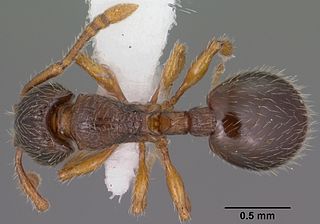
Myrmicini is a tribe of ants in the subfamily Myrmicinae. It is not to be confused with the very similar-sounding tribes Myrmecinini and Myrmeciini, which is in the subfamily Myrmeciinae. While the type genus of Myrmicini is Myrmica, that of Myrmeciini is Myrmecia and that of Myrmecinini Myrmecina.

The Siberian Elm cultivar Ulmus pumila 'Pendula' is from northern China, where it is known as Lung chao yü shu. It was classified by Frank Meyer in Fengtai in 1908, and introduced to the United States by him from the Peking Botanical Garden as Weeping Chinese Elm. The USDA plant inventory record (1916) noted that it was a "rare variety even in China". It was confirmed as an U. pumila cultivar by Krüssmann (1962).

The Siberian elm cultivar Ulmus pumila 'Dwarf Weeper' was discovered in a western Illinois garden and sold by the Arborvillage Nursery Holt, Missouri.

Crematogastrini is a tribe of myrmicine ants with 64 genera and 8 fossil genera.

Lecanopteris is a genus of ferns in the family Polypodiaceae, subfamily Microsoroideae, according to the Pteridophyte Phylogeny Group classification of 2016 (PPG I). They have swollen hollow rhizomes that provide homes for symbiotic ants. All are epiphytic plants that naturally occur from Southeast Asia to New Guinea. Several species are in commerce, being grown as houseplants and greenhouse curiosities.
Myrmecina alpina is a species of ant in the family Formicidae.
Myrmecina difficulta is a species of ant in the family Formicidae.
Myrmecina eruga is a species of ant in the family Formicidae.
Myrmecina inaequala is a species of ant in the family Formicidae.
Myrmecina silvalaeva is a species of ant in the family Formicidae.
Myrmecina silvampla is a species of ant in the family Formicidae.
Myrmecina silvangula is a species of ant in the family Formicidae.
Myrmecina silvarugosa is a species of ant in the family Formicidae.
Myrmecina silvatransversa is a species of ant in the family Formicidae.
Myrmecina wesselensis is a species of ant discovered and described by Shattuck, S. O. in 2009. This species is known from a single worker collected foraging on the ground at night from the Wessel Islands, Northern Territory.

Myrmecina is a genus of ants in the subfamily Myrmicinae. It contains 51 species distributed in North America, Europe, northern Africa, India east, Korea, Japan and Australia.

Osmia pumila is a species of bee in the family Megachilidae. It is found in Central America and North America.

Myrmecina americana is a species of ant in the family Formicidae.

Ant-Man and the Wasp is the film score for the Marvel Studios film Ant-Man and the Wasp. The score was composed by Christophe Beck. Hollywood Records released the album digitally on July 6, 2018.

Myrmecina graminicola is a species of ant found throughout Northern Africa, Europe, Asia, and elsewhere in the Palearctic realm. Its colonies build nests in soil, under rocks, and in leaf litter. It was described in 1802 by Pierre André Latreille, initially in the genus Formica. They are not an aggressive species. When a worker encounters an intruder, it starts to play dead with its legs and antennae folded. They live in colonies that have less than 100 workers and one queen. Before mating, the female ant releases a pheromone that the male ant is attracted to this and the mating then occurs seconds after. The ant colonies move around following the queen’s pheromone trail.








